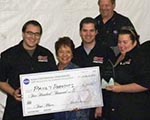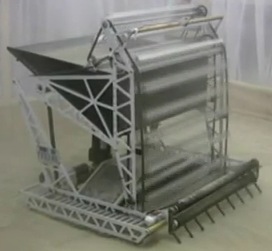NASA uses Open Innovation Contest to develop Moonraker
Published Nov-11-09Breakthrough:
A lightweight robotic vehicle that’s sturdy and powerful enough to excavate soil on the moon.
Company:
Paul's Robotics, United States
The Story:
 If humans are ever going to live on the moon or indeed if we are to harness some of its natural resources we’re going to need the tools to be able to dig up and dump thousands of tones of lunar soil. The space agency NASA went looking for an open source solution and held a series of contests focused on developing new and improved handling technologies for moon dirt, known as lunar regolith.
If humans are ever going to live on the moon or indeed if we are to harness some of its natural resources we’re going to need the tools to be able to dig up and dump thousands of tones of lunar soil. The space agency NASA went looking for an open source solution and held a series of contests focused on developing new and improved handling technologies for moon dirt, known as lunar regolith.Moon Mud
Unlike the situation here on Earth the top soil on the moon has not been worn down by millions of years of erosion by the sea. It has sharp jagged edges which makes it unsuitable for some of the things that future colonies may want to use it for. For example it could tear space suits and clog up air locks. If a way can be found to mine and collect the moon dirt safely it can be used as building material for lunar bases.
Moon Mud Sticks
Lunar regolith presents a variety of challenges to the engineer. In fact so difficult are they to contend with that none of the teams entering the 2007 and 2008 competitions met the winning criteria. Lunar regolith is not easy to work with, its particles stick together making it a difficult dig.
Other challenges were imposed by the contest organizers; the robots could not weigh more than 80 kilograms but they had to be sturdy and powerful enough to scoop up the dirt and move through the dust.
Leaving the Competition in the Dust
But then along came Paul’s Robotics, a team led by college student, Paul Ventimiglia of Worcester Polytechnic Institute. It was one of 23 teams attracted to the open source innovation contest and won the overall prize of $500,000. Prize money was also given to second and third place teams.
The challenge (one of NASA’s Centennial Challenges) required teams to build a robot to navigate, excavate and transfer 150 kilograms of simulated regolith and deposit it in a container in thirty minutes or under. Each remotely controlled vehicle also had to carry its own power source.
For two days in October 2009 teams pushed their robots to the max in a “sandbox” that contained eight tons of simulated regolith material. The winning robotic vehicle, called Moonraker managed to shift an earth shattering, or lunar soil shattering 439.7 kilograms of regolith. It was its third time in the open source competition, but Ventimiglia and his colleagues learned from previous failed attempts and made various modifications.
“Two of the winning teams were returning competitors and have learned through this challenge that there is no such thing as failure, “said Andrea Seastrand, executive director at California Space Authority Inc. of Santa Maria. “It's great to see them rewarded for their determination, innovation and creativity."
Ventimigelia and his team spent many sleepless nights constructing and programming Moonraker. The robot consists of a number of continuously rotating scoops to collect the soil and deposit it in a bin that it carries. Once full the team navigated Moonraker to the collection container where it deposited the dirt via its collector arm.
Moon Mission?
It is unlikely that the winning robot will ever leave the Earth, but NASA is hopeful that the technologies they witnessed during this competition will find use in future missions to the moon.
Next Story »

